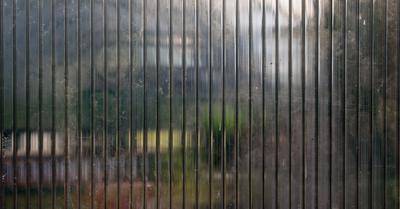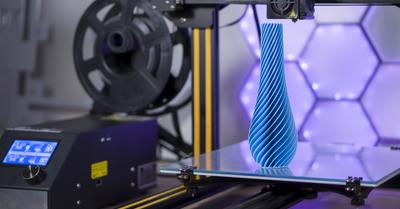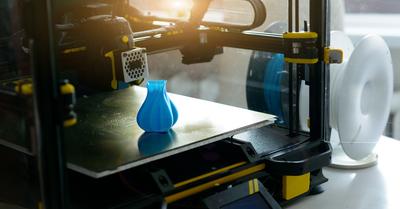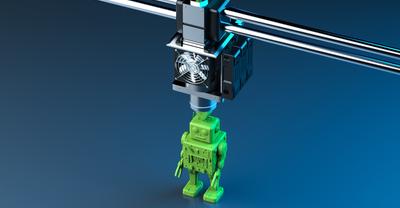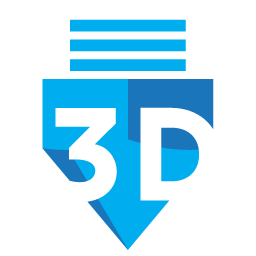Polymer 3D-Printing Processes
The first umbrella of 3D printers will be types that can print polymer materials. These include nylons and commonly used thermoplastic filaments.
Material Extrusion
Material extrusion is a 3D printing process where the filament is from a solid thermoplastic material which is heated and pushed through a nozzle. The melted thermoplastic “ink” are the printer’s deposits which builds the desired design on a physical platform.
Materials: A wide variety of thermoplastic filaments are popular for material extrusion. Common printing filaments such as the following are used:
- Polylactic acid (PLA) filaments,
- Acrylonitrile Butadiene Styrene (ABS) plastic,
- Polyethylene terephthalate filaments (PET),
- PET-G (less brittle than PET with the addition of glycol),
- TPU filament
- More recently, PolyEther Ether Ketone (PEEK) has been used.
Resolution (of most FDM and FFF printers): within the lower limit of ±0.5 mm
Common applications: Popular for hobbyists
Strengths: Good surface finish; Great for full color in addition to the wide selection of material options.
Weaknesses: Brittle and not sustainable for mechanical parts. Different material selection can vary the strength.
Fused Deposition Modeling (FDM)
Fused Deposition Modeling was originated by Scott Crump from Stratsys. Virtual identical technology, called Fused Filament Fabrication, was founded by Makerbot, and now the two terms (FDM and FFF) are used interchangeably.
FDM is a common desktop 3D Printing technology for plastic parts and therefore a popular choice by hobbyists. Additionally, an open-source community called RepRap has developed with the patent expiration and is a great resource for DIY projects and questions.
Recommended products:
Key features: Extrudes a plastic filament layer-by-layer onto the build platform *(Bottom-up printing process)
Process Overview:
- A spool of filament is loaded into the 3D printer
- The filament is fed through the nozzle in the extrusion head
- The printer nozzle is heated in when the motor pushes the filament through the nozzle, the heat causes the filament to melt
- After one layer is complete, another layer is laid down
Are Support Structure needed?
- Yes, support structures are often necessary depending on the geometry. If a model has an excessive overhanging part, then it will need to be supported with another material.
Pros:
- Affordable options and also come in forms on a 3D pen
- Great for Lego, plastic gear, etc.
- Can be printed with production-grade thermoplastic.
Cons:
- Better for prototype than production
- Low resolution
- Rough surface and lacks (adhesion) strength.
Basic methods for a hobbyist with this type of printer:
- 3D CAD model to build is exported as a STL, OBJ, or VTK (depending on the slicer to be used).
- 3D model is processed through the slicer software for a meshed, pre-determined pattern.
- The x-, y-, and z-coordinates from the slicer is fed to the 3D printer and the pattern for printing is provided.
- The heated filament which melted, is soon hardened over the layer underneath and most temperatures are controlled.
- Printing time will depend on the size, complexity, and chosen “resolution” of your print from the slicer software.
Here is a great video to visualize the overview
Vat Polymerization
A Vat polymerization, or photopolymerization, is a process in which a photopolymer resin is cured by a light source. This process in chemistry is called polymerization hence the name being, Vat polymerization. “Vat” comes from the tank in which the liquid photopolymers are contained in.
The main difference between the two well-known Vat polymerizations, SLA and DLP, is the type of light source that cures the resin. An SLA uses a point laser light while the DLP uses a voxel approach.
Within this category, both top-down and bottom-up approaching are being appreciated. In general, the process is similar as both methods require the Vat tank.
Materials: Photopolymer Resin
General VAT polymerization Resolution: ±0.15 mm
VAT polymerization materials are known for low cost but rather high resolution
Common uses:
- All types of prototypes; commonly used by product developers and engineers for such prototypes.
- Medical and dental applications
- Jewelry
Strengths: smooth surface, high resolution, and low cost, various colors
Recommended products for SLA/DLP/MSLA
- Mars Pro MSLA 3D printer
- Orange 3D SLA 3D printer
Stereolithography (SLA)
SLA is the original Industrial 3D Printing Process, invented by Chuck Hull in 1986. He filed the patent for the SLA-1 machine. The SLA is also known as SL, photo-solidification, optical fabrication, and resin printing.
Key Features
- Uses UV laser and mirrors, known as galvanometers. These galvanometers are positioned on the x-axis and y-axis.
- A layer-by-layer build
Process overview
The galvos are used to aim the laser beam across a vat of resin.
- This process of aiming the laser cures and solidifies a cross-section of objects inside a building area in the projected shape
- The process proceeds as the build platform moves up (or down, depending on the specific 3D Printer).
- After processing, the part sits in a chamber to fully cure.
Are Support Structure needed?
- Yes, support structures are often required
Common Materials
- Epoxy-based or acrylate-based resins
Pros
- High level of details (High Resolution)
- Smooth surface finishes
- Tight tolerances
Cons
- Lengthy post-processing (required)
Digital Light Process (DLP)
As mentioned previously, a DLP is very similar to SLA, but the key difference is that DLP cures liquid using a digital light projector screen.
Key Features
- Light is projected onto the resin via light-emitting diode (LED) or a UV light source
- A full and single image is projected on each layer all at once
Process Overview
- Build surface is consisted of DMD, a digital micro mirror device. This is an array of micro-mirrors which controls the light projection location and the overall generation of the light pattern on the build surface.
- The LED or UV light uses these DMD to project a single image of light pattern on the build surface
- Once the material has polymerized, the printer proceeds to the next image, or cross-section.
Pros
- DLP can image an entire layer of the build at once hence increasing the overall build speed (in comparison to SLA)
Cons
- Resolution is restricted to voxels. Voxels are the 3-dimensional rectangular pixels resulting from the image projected.
Masked Stereolithography (MSLA)
Masked stereolithography is similar DLP as it uses an image to print. In MSLA printing, an array of lights is covered by a digital mask which permits the pattern of light to pass through to make a specific design.
Overview:
- The UV light that shines through the LCD screen displaying a single layer of the mask hits the resin that can then polymerize
- All layers can be printed almost at once
Pros
- MSLA uses an array of multiple individual emitters rather than a single point emitting light source such as the DLP.
- Lower costs of LCD make this type a viable selection for a budget friendly desktop resin printer.
- Extremely high throughput, as multiple layers can be printed at once.
Cons
- LCD photo mask is also composed of square pixels (like the DLP)
- Unlike DLP, the XY accuracy cannot be adjusted as it is fixed and independent of the zoom/scale of the lens
Check out this video of MSLA if you want to see the print process yourself!
Powder Bed Fusion (Polymers)
In powder bed fusion for polymers, a thermal energy sources electively induces merging between powder particles inside a build area. The merging polymers create the desired solid object.
Materials:
- Powder bed fusions are preferred for its strong selections of materials such as thermoplastic powder, Nylons such as Nylon 6, Nylon 11, and Nylon 12, Alumide, Rubber-like materials
Resolution: ±0.3 mm
Strengths:
- Powder bed fusion can be used to build mechanical parts with reliable properties. Due to the process, complex geometries are attainable such as hollow designs.
Weakness:
- Generally, longer lead times/production time. Higher cost than comparable print options such as FFF.
Recommended products of Powder Bed Fusion
Selective Laser Sintering (SLS)
Selective laser sintering, SLS, is the commonly known method of powder bed fusion. The 3D printing process in which the polymers are merged together by thermal energy source is often referred to as SLS
Key Features
- A CO2 laser sinters a desired cross section on a thin layer of polymer powder.
Process Overview
- A bed of the polymer powder is heated yet below the polymer’s melting point.
- A recoating blade, also known as a “wiper”, deposits a super thin layer of the powder-like material onto the building platform, which provides a fresh layer of material for the build.
- Then, a CO2 laser beam scans the build’s surface. This laser beam selectively sinters the polymer to solidify a cross-section of the desired object by the help of galvos.
- When the entire cross-section is scanned, then the platform will move down one-layer thickness. A new coat of material is then deposited on the surface.
- After the build is complete printing, the excess powder bed is brushed off the part and then bead-blasted.
Are support structures needed?
- SLS doesn’t require support structures so the whole build platform can be utilized to nest multiple parts in a single print.
Pros
- Melts nylon-based powders into solid plastic
- Real thermoplastic, therefore they are durable and tough.
- Supports hinges and snap-fits
Multi Jet Fusion (MJF)
Multi Jet Fusion additive manufacturing technology was founded by HP in May 2016 and wasn’t necessarily fit into the ISO/ASTM 52900 from 2015.Yet it fits with the powder bed fusion family although it shares characteristics of both SLS and material jetting (next section).
Key Features and Process Overview
- MJF also builds from nylon powder.
- This method uses two perpendicular carriages;
- One applies a fresh layer of material
- The other inkjet array applies fusing agents to the nylon powder. MJF also provides two fusing agents. One provides the sintering while the other is known as a detailing agent that inhibits sintering.
- An energy element passes over the bed to fuse the layers, in a continuous pass
- A key aspect of MJF is the precise control of measuring and instructing energy variations within the bed to control optimal fusing. This provides the build a mechanically stronger, accurate, and repeatable process.
Pros
- Due to the enhanced fusing agent pair, surface finish and mechanical cohesion (and overall quality) is enhanced in comparison to SLS
- Build time is much more accelerated
Recommended products
- Polyjet can be found on their major manufacturer’s website, Stratasys
Material Jetting
In Material Jetting, droplets of material are deposited on a build plate then the polymers or wax materials are cured by light exposure (e.g., photopolymers). These formations are cured as the object is built layer by layer.
Materials: Photopolymer resin
Resolution: ±0.1mm
Common Application:
- Great for prototypes
- Full design with multiple colors
Strengths: Great surface finish, full color and multi-material compatible
Weakness:
- High cost
- Brittle and not suitable for mechanical parts over time due to the properties of UV-activated polymers
Drop on Demand (DOD)
Drop on demand uses a pair of inkjets to deposit the droplet of materials. One is the typical wax-like material that builds the material and the other is the support material that can later be dissolved.
Key Feature
- DOD follows a path in a point-wise deposition to complete a cross-sectional area
- Once a layer is fully deposited, a fly-cutter scans the surface and perfectly flattens and smooths each layer before the next layer commences.
Pros
- Great for using lost-wax casting or investment casting
PolyJet Material jetting
Think about material jetting similar to an inkjet printer printing multiple layers of ink upon each other to create a solid part.
Key feature
Hundreds of tiny droplets of photopolymers are deposited then cured upon UV light exposure.
A key difference for material jetting is that it prints in a line-wise fashion instead of printing an entire cross-sectional area like most printing methods.
Pros
Can print multiple parts within a single line of deposit.
Can print multi-material and full color
Useful to prototype elastomeric material
Binder Jetting
During a binder jetting process, regions within a powder bed are selectively bound by liquid bonding agents. Binder jetting is often recognized as being similar to SLS but unlike the SLS, a binder jetting requires an initial layer of powder on the build platform for the bonding action to be initiated.
In binder jetting technology, binder droplets are deposited onto the powder which activates and binds the powder form to a solid object. Each layer of these droplets is processed on top of another as the build is lowered after each layer.
Material: The powder forms on the platform that the agent binds (depending on the machine)
- Sand
- Metal powder
- Ceramic (glass or gypsum)
Resolution: 0.22 mm for metal and 0.3 mm for sand
Common Applications
- Architectural models that require high aesthetics (and form)
- Toys
- Figurines
- Packaging
Strengths:
- low-cost and available for large builds.
- Metal binding also builds functional metal parts with relatively good mechanical properties
Weakness
- Poorer mechanical properties in comparison to Selective Laser Sintering or DMLS. This is understandable as not all the grains of the materials are fused completely.
Sand binder jetting
Sand binding uses the binding 3D technology to produce builds from sand (e.g., sandstone, or gypsum).
- Sand binding can be fabricated from plaster based PMMA powder joined with a liquid binding agent
- Full color models can be built by following the first binding agent with a secondary print head that jets color
- Once parts are cured, strengthened (within the bed), and cleaned, the parts are then exposed to an infiltrant material to enhance mechanical properties furthermore.
Metal Binder jetting
- Metal powders can also be bound via binder jetting, but by polymer binding agents.
- This provides complex shapes of metal production parts in comparison to traditional metal manufacturing and processing.
Sheet Lamination (SL, LOM)
Sheet lamination (SL), also known as LOM, Laminated Object Manufacturing Technology, works by fusing or laminating layers of plastic or paper by using heat and pressure to form a final 3D object.
LOM was founded by a Californian company called Helisys Inc, now Cubic Technologies.
Materials
- Materials can vary depending on the technology. These are just a few examples of many.
- PolyVinyl Chloride, PVC
- Paper
- Carbon fiber sheets
Process Overview
- Thin sheets of materials are supplied often by feed rollers
- The sheet is adhered to a substrate via a heat roller
- The blade or laser cuts the sheet into a desired shape cross-section.
- Areas of the sheet that are not used for the part are cross hatched to facilitate removal
- Then a new layer of material from the platform is rolled over the new layer, as the platform goes down a single layer.
- The new sheet is adhered by a heated roller to the previous layer and then the blade cuts the next cross-section.
Applications
- Ergonomic studies
- Topography models
- Paper-made objects
Strengths
- Great for large 3D Prints
- Fairly low cost
- Quick production
Although sheet lamination is not the most popular technique, it is still commonly used by architects, artists, and product developers.
Metal 3D Printing
This second umbrella consists of 3D printing for metals. Although the previous binder jetting consisted an overview of metal binder jetting, the following sections will cover 3D prints that mainly focus on pure metal builds.
Powder Bed Fusion of Metal
In metal powder bed fusion, the solid objects are produced by fusing metal powder particles by thermal source activation rather than a binding process mentioned in the previous section (metal binder jetting).
- Materials: Aluminum alloys, Stainless steel, and Titanium
- Resolution: 0.1 mm
- Strength: Stronger prints compared to polymer prints. Capable of manufacturing/producing complex geometries for metal products
- Weakness: Small build sizes. High price point
Direct Metal Laser Sintering (DMLS)/Selective Laser Melting (SLM)
The process of DMLS and SLM are similar to SLS.
- Often used for
- Metal reduction alternative
- Multi-part assemblies into a single component
- Make internal channels or hollowed out features
DMLS vs. SLM
- DMLs only heats the powder to a temperature where the metals can fuse on a molecular level. (Hence, the strength of the final build)
- SLM uses a laser to achieve a full melt of the metal powder. Since this requires the part to form a homogeneous part, it results in a single melting temperature build.
Therefore, DMLS can produce parts in alloys (e.g., aluminum alloys), but SLM can only make titanium.
Are structural supports required?
- Due to the nature of the density and weight of the metals, DMLS and SLM requires. Structural support during the printing process.
Pros
- Both methods are good for complex geometries
Cons
- Requires structural support as both DMLS and SLM are at risk of warping due to the stress produced from the printing process
- Parts should also be relieved of any stresses such as heat treatment after the parts are printed
Electron Beam Melting (EBM)
EBM is a powder bed fusion process which uses an electron beam controlled by electromagnetic coils to direct the print pattern.
The focused electron beam melts the metal powder in the printing bed as it scans across the layer of powder.
Key features
- The high energy beam induces the fusion between the particles.
- EBM is generally a faster selection of printing (in comparison to SLM and DMLS) due to the higher energy density between each layer.
- The print is executed in a heated up and vacuumed environment
- Temperature is controllable depending on the metal alloy
Directed Energy Deposition Technology
The final category is the DED technology. DED is commonly referred to as Direct Metal Deposition (DMD), Laser Engineered Net Shaping (LENS), and Electron Beam Additive Manufacturing (EBAM). This is a unique method of depositing metal through a nozzle while simultaneously melting the metal.
Key Overview
- The material being deposited are either in powder or wire form.
- When it is being deposited, it is simultaneously melted by a direct heat source (usually a laser, electron beam, or a plasma arc).
- The layer is solidified and built layer by layer until complete.
Materials
- Metal powder (few examples of metals available for 3D printing)
- Copper
- Aluminum
- Titanium
- Stainless Steel
- Wire source materials
Common Applications
- DED is commonly used for repairing or adding material to existing components.
- It is more often used for industrial applications such as repairing turbine blades and propellers rather than builds.
Strengths
- Great for industrial purposes
- Repairs (turbine blades, propellers, etc.)
Weakness
- Large footprint
- Requires a closed and controlled environment
Final Thoughts
Generally speaking, your selection of a 3D printer will widely depend on the application, budget, and overall project. Whether it is a metal object that you want to build or a polymer-based build, there are various options and choices that you can pick from for your next great purchase.



